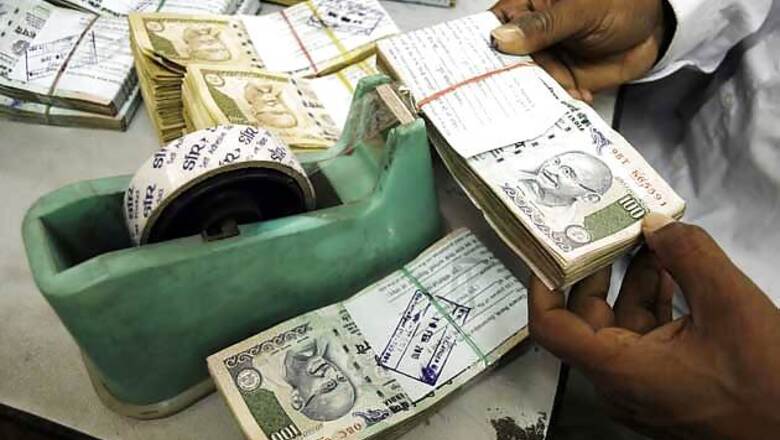
views
New Delhi: Fitch Ratings has revised India's outlook to negative from stable. Its Long-Term Foreign- and Local-Currency Issuer Default Ratings (IDRs) have been affirmed at 'BBB-' and Short-Term Foreign Currency at 'F3'. India's Country Ceiling is also affirmed at 'BBB-'.
The Outlook revision reflects heightened risks that India's medium- to long-term growth potential will gradually deteriorate if further structural reforms are not hastened, including measures to enhance the effectiveness of the government and create a more positive operational environment for business and private investments. The Negative Outlook also reflects India's limited progress on fiscal consolidation and, in particular, on reducing the central government deficit despite improvement in the financial health of state governments.
"Against the backdrop of persistent inflation pressures and weak public finances, there is an even greater onus on effective government policies and reforms that would ensure India can navigate the turbulent global economic and financial environment and underpin confidence in the long-run growth potential of the Indian economy," said Art Woo, Director in Fitch's Asia-Pacific Sovereign Ratings group.
The rating affirmation reflects India's diversified economy and its high domestic savings which reduce reliance on foreign investors for private investment and fiscal funding. The Indian government is able to issue long-term debt at a low cost in its own currency. Net external debt is very low and still high foreign exchange reserves of the Reserve Bank of India (RBI) provide a cushion against potential external shocks. The underlying drivers of the last decade of rapid economic growth remain in place - a fast growing pool of educated workers and an innovative private services sector.
Fitch, however, notes that India faces an awkward combination of slowing growth and still-elevated inflation. Real GDP grew just 6.5 per cent yoy in FY2011-12 (end-March 2012), down from an 8.4 per cent rise in FY2010-11. India also faces structural challenges surrounding its investment climate in the form of corruption and inadequate economic reforms. Fitch forecasts real GDP to rise 6.5 per cent yoy in FY13, down from a previous projection of 7.5 per cent. Headline wholesale price index (WPI) rose 7.6 per cent yoy in May 2012, up from 7.2 per cent yoy in April. Fitch is projecting WPI to rise by an average of 7.5 per cent in FY2012-13 which, though lower than the 8.8 per cent rise in FY2011-12, continues to be higher and stickier than Fitch previously expected, diminishing scope for monetary policy flexibility.
India's public finances are a key rating weakness compared with other 'BBB'-rated sovereigns, which constrains scope for fiscal policy flexibility. Fitch estimated general government debt stood at 66 per cent of GDP at end-FY2011-12, against the 'BBB' median of 39 per cent. Moreover, India's government revenue in-take is low at 19.4 per cent of GDP. The central government fiscal deficit climbed to 5.8 per cent of GDP in FY2011-12, against a target of 4.6 per cent, largely reflecting an overshoot in subsidy spending. The government has repeatedly delayed reforms to the tax and subsidy systems. The confluence of weaker economic growth and a large subsidy bill means India will likely miss its 5.1 per cent of GDP deficit target for FY2012-13; Fitch expects it to be 5.6 per cent-5.9 per cent of GDP. General elections due in early 2014 could see politically driven pressure to loosen fiscal policy, which could further weaken India's public finances relative to peers.
India's external financial position remains a rating strength, although this is eroding as foreign exchange reserves have fallen (11 per cent since August 2011) and net external indebtedness is rising. Reserves remained at USD286bn as of end-May 2012, equal to six months of current external payments, which still provides the sovereign with an important buffer during periods of elevated global risk aversion. The sovereign is a net external creditor to the tune of 10.2 per cent of GDP at end-FY2011-12, against the 'BBB' median of 3.3 per cent of GDP or the 'BB' median of negative 4.1 per cent of GDP. Slowing growth should curb the current account deficit and slow the weakening of the external finances, although oil prices pose a risk. Prolonged and intensified pressure on the currency and/or foreign reserves would be negative for the credit profile.
A significant loosening of fiscal policy, which leads to an increase in the gross general government debt/GDP ratio, would result in a downgrade of India's sovereign ratings. In addition, a material downward revision of Fitch's assessment of the India's medium-term growth potential along with persistent high inflationary pressure would hurt India's sovereign creditworthiness. Conversely, an improvement in India's investment climate, which supports greater infrastructure investment and a sharp sustained decline in inflation, would be supportive for India's sovereign ratings. Fiscal consolidation and structural budget reform would also support the ratings.
(The above statement was released by the rating agency)



















Comments
0 comment